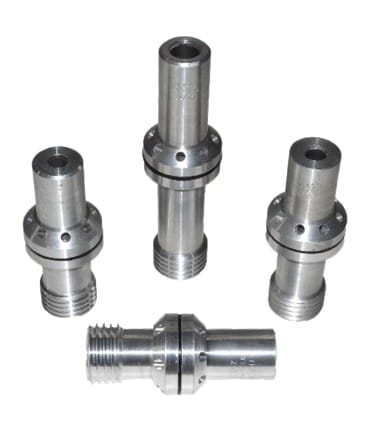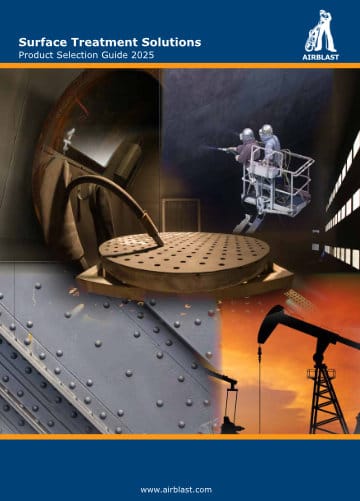Wet blasting WIN nozzles
Water Injection Nozzle – Tungsten Carbide with Aluminium Jacket
Airblast high velocity venturi style nozzles have been designed specifically to give maximum blast cleaning rates, uniform abrasive distribution and efficiency over an extensive operating life. Through the venturi principle the air and abrasive mixture is accelerated as it exits the nozzle. Venturi nozzles increase productivity and reduce abrasive consumption with approximately 40% as compared to straight bore nozzles. Airblast offers a full selection of nozzles with different orifice diameters, sizes, and insert / jacket materials.
Do you have questions about how we can help your company? Send us an email and we’ll get in touch shortly.
- More than 50 years of experience
- Airblast offices in 12 countries
Product description
Size
The orifice size of the blasting nozzle determines the cleaning rate, abrasive consumption and air consumption. When choosing a nozzle you should consider the cleaning rate required, available compressed air, size of the blast pot and the internal diameter of the piping, the blast hose and the air hose. In most blasting operations a number 5 (with 8 mm orifice) or number 6 (with 9,5 mm orifice) nozzle is used. Have a look at the consumption chart on the back of this datasheet for the compatible combinations.
Material
Tungsten carbide is the market standard and is a cost effective yet durable option. Silicon Carbide and Silicon Nitride nozzles are more wear resistant and reduce operator fatigue due to their light weight. Boron carbide nozzles offer the best resistance against wear.
As blast nozzles wear the orifice enlarges increasing air consumption and decreasing the venture effect resulting in slower abrasive speeds – nozzle wear should be monitored on a daily basis and worn nozzles replaced to maintain effective and efficient production.

WIN - Tungsten Carbide Water Injection Nozzle with Aluminium Jacket and 50 mm large thread
| Part no. | Description | Orifice | Length | Inlet |
| 24600 | WIN-4/50 Water Injection Nozzle | 6,4 mm | 149 mm | 25 mm |
| 24610 | WIN-5/50 Water Injection Nozzle | 7,9 mm | 158 mm | 25 mm |
| 24620 | WIN-6/50 Water Injection Nozzle | 9,5 mm | 171 mm | 25 mm |
| 24630 | WIN-8/50 Water Injection Nozzle | 12 mm | 227 mm | 25 mm |
Compatibility guide
| No. | Nozzle Orifice | Recommended range | Minimum Blast Machine capacity | Minimum Pipe ID | Blast Hose ID | Minimum Air Hose ID | |
| m³/min | CFM | ||||||
| 3 | 5.0 mm | 1.27 – 2.29 | 45 – 81 | 60 ltr. | 1” | ¾” | 1” |
| 4 | 6.5 mm | 2.29 – 3.88 | 81 – 137 | 60 ltr. | 1” | 1” – 1¼” | 1¼” |
| 5 | 8.0 mm | 3.88 – 5.55 | 137 – 196 | 100 ltr. | 1” | 1” – 1¼” | 1¼” |
| 6 | 9.5 mm | 5.55 – 7.19 | 196 – 254 | 200 ltr. | 1¼” | 1¼” | 1½” |
| 7 | 11.0 mm | 7.19 – 9,57 | 254 – 338 | 200 ltr. | 1¼” | 1¼” – 1½” | 2” |
| 8 | 12.5 mm | 9.57 – 15.52 | 338 – 548 | 200 ltr. | 1¼” | 1½” | 2” |
Note: Best performance is obtained when sizes of nozzle, blast machine piping, blast hose and air hose are properly matched.
- m³/min and CFM range is based on blasting at 7 bar (100 psi) for the life of the
- Blast machine capacity should allow 20 to 30 minutes of blasting.
- Hose ID should be three to four times the size of the nozzle
Nozzle pressure / Nozzle diameter guide
| ORIFICE (mm) (“) | 60 PSI | 4.2 BAR | 70 PSI | 4.9 BAR | 80 PSI | 5.6 BAR | 90 PSI | 6.3 BAR | 100 PSI | 7.0 BAR | 120 PSI | 8.5 BAR | |||
| 5.0 mm 3/16” | 30.0 171.0 7 | 0.85 77.00 5.3 | 33.0 196.0 8 | 0.93 89.00 5.6 | 38.0 216.0 9 | 1.08 96.00 6.4 | 41.0 238.0 10 | 1.16 108.00 7.1 | 45.0 264.0 10 | 1.27 120.00 7.5 | 58.0 375.0 12 | 1.64 170.00 9.0 | Air Abrasive Power | CFM Lbs./hr. hp | m³/min KG/hr. * kw |
| 6,5 mm 4/16” | 54.0 312.0 12 | 1.53 141.00 9.0 | 61.0 354.0 14 | 1.73 160.00 10.1 | 68.0 408.0 16 | 1.93 185.00 11.6 | 74.0 448.0 17 | 2.10 203.00 12.4 | 81.0 494.0 18 | 2.29 224.00 13.5 | 105.0 660.0 22 | 2.97 300.00 16.2 | Air Abrasive Power | CFM Lbs./hr. hp | m³/min KG/hr. * kw |
| 8.0 mm 5/16” | 89.0 534.0 20 | 2.52 242.00 15.0 | 101.0 604.0 23 | 2.86 274.00 19.1 | 113.0 672.0 26 | 3.20 305.00 20.2 | 126.0 740.0 28 | 3.57 335.00 21.0 | 137.0 850.0 31 | 3.88 385.00 22.9 | 160.0 1.050.0 37 | 4.53 476.00 27.5 | Air Abrasive Power | CFM Lbs./hr. hp | m³/min KG/hr. * kw |
| 9.5 mm 6/16” | 126.0 764.0 28 | 3.57 346.00 21.0 | 143.0 864.0 32 | 4.05 392.00 24.0 | 161.0 960.0 36 | 4.56 425.00 27.0 | 173.0 1.052.0 39 | 4.90 477.00 28.9 | 196.0 1.152.0 44 | 5.55 523.00 33.0 | 235.0 1.475.0 52 | 6.65 669.00 39.6 | Air Abrasive Power | CFM Lbs./hr. hp | m³/min KG/hr. * kw |
| 11.0 mm 7/16” | 170.0 1.032.0 38 | 4.81 468.00 28.5 | 184.0 1.176.0 44 | 5.21 533.00 32.6 | 217.0 1.312.0 49 | 6.14 595.00 36.4 | 240.0 1.448.0 54 | 6.80 657.00 40.1 | 254.0 1.584.0 57 | 7.19 719.00 42.4 | 315.0 2.050.0 69 | 8.92 930.00 50.9 | Air Abrasive Power | CFM Lbs./hr. hp | m³/min KG/hr. * kw |
| 12.5 mm 8/16” | 224.0 1.336.0 50 | 6.34 606.00 37.5 | 252.0 1.512.0 56 | 7.14 686.00 42.0 | 280.0 1.680.0 63 | 7.93 762.00 46.9 | 309.0 1.856.0 69 | 8.75 842.00 51.8 | 338.0 2.024.0 75 | 9.57 918.00 56.3 | 410.0 2.650.0 90 | 11.61 1.202.00 67.6 | Air Abrasive Power | CFM Lbs./hr. hp | m³/min KG/hr. * kw |
Chart shows calculated consumption rates of air and abrasive for new nozzles. When slecting a compressor add 50% to above figures to allow for normal nozzle wear and friction loss.
* Based on abrasive density of 1,5 kgs. per liter.
NOTE: Figures may vary depending upon working conditions. To maintain desired air pressure as nozzle orifice wears, air consumption increases.
The effects of nozzle wear on air consumption must be considered when selecting nozzles and the compressors that support them.


